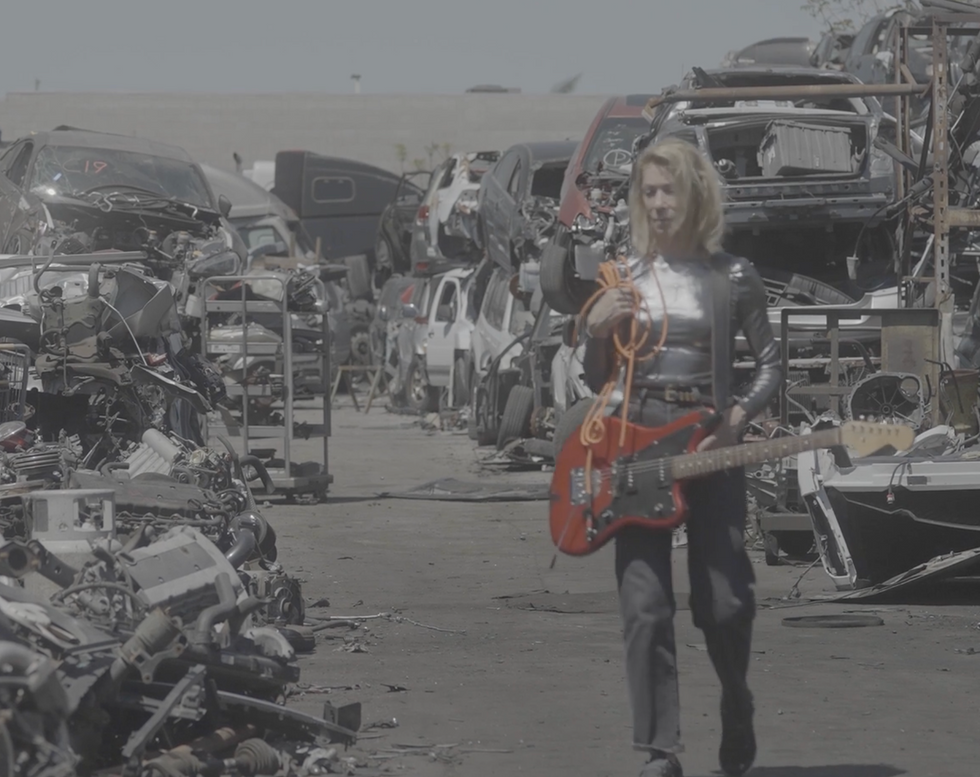
Kim Gordon stands alone in a desolate junkyard, surrounded by stacks of destroyed vehicles and the occasional puff of dust. Tires, contorted metal and fragmented car doors create a maze for the iconic noise musician to slowly walk through, assessing all surfaces like a curious alien who’s landed on earth after we inevitably destroyed ourselves in the apocalypse.
Gordon holds a red electric guitar, with cords wrapped loosely around her shoulder, before pressing its body against a metal surface with intent. At contact, a painful screeching sound interrupts the silence and continues on as she drags the guitar. She repeats this throughout the California wasteland, with only small breaks in-between the instrument’s unforgiving shrill.
This is 12341 Branford St. Sun Valley, a 2022 short film co-directed by Gordon with her collaborator Manuela Dalle. It’s currently screening as part of Efraín López’s group exhibition, Single Channel, open in New York City through March 1, alongside artists like Felipe Romero Beltrán, Paul Stephen Benjamin and Cristine Brache.
Below, PAPER caught up with Gordon to learn more about the art piece after a recent viewing where the artist was present.
What was the impetus for this concept? Is it something you’ve always wanted to do? It almost felt like a kid in a candy store for an artist like you, running around a junkyard and making noise with your guitar so freely.
It’s a continuation of the first video I did with Manuela Dalle, which was using corporate building downtown and store facades at a mall as surfaces for potential sound making — like giant guitar slides, sort of a way of reclaiming these male symbolic structures and giving them a different purpose.
For those who don’t understand what’s happening sonically in this film, can you explain what’s causing the sounds created by your guitar against the metal of these cars? And was it recording the audio exactly as it happened in real time?
So I had a small practice amp that was plugged into my guitar and the sound was recorded in real time. I’m guiding the guitar. The sound comes from the movement and friction between the guitar and the pickups against the metal and the unevenness of the crushed and bent surfaces.

How did you work, in terms of the communication process and real-time creative, with Manuela capturing you? Was everything outlined explicitly beforehand or was there a level of spontaneity throughout?
It was all spontaneous except for the beginning and ending, and sometimes Manuela would say, “Look into the camera.” I like that part in the film as it’s all really a performance, so it acknowledges it.
What was the collaboration process like between you and Manuela? What elements of each other do you see reflected throughout the film?
It was an idea that she initially came up with after we did the video downtown where I wanted to use the city’s architecture. And speaking about this French film, Titane. I had this other idea to do the one based on a Chantal Ackerman film in my house.

I noticed that you don’t use your speaking or singing voice anywhere. It’s just ambient noise and the guitar. Was that an intentional consideration of yours?
I don’t see this as a music piece, but more of an art work. I wasn’t trying to make a music piece.
What did you intend to say when you set out to make this film and, now watching it back several times, what do you think it really says? For me, there was a dialogue between a sort of toughness and fragility present. Does that resonate?”
I was initially inspired by that French film, Titane, where this girl has a piece of metal implanted in her and has a love of cars. I wanted it to feel a bit dystopian, like I was an alien coming upon these dead machines.
I wanted it to feel a bit dystopian, like I was an alien coming upon these dead machines.
Photos courtesy of Efraín López
